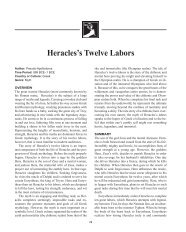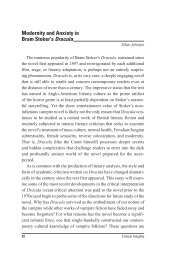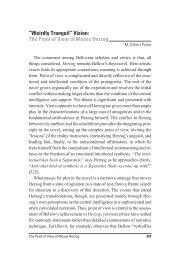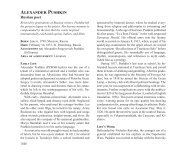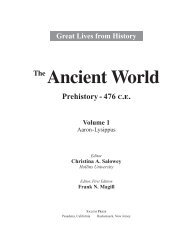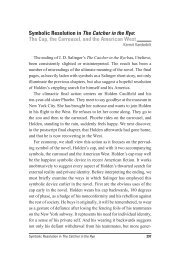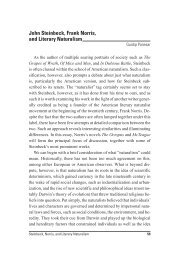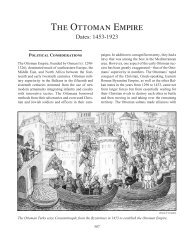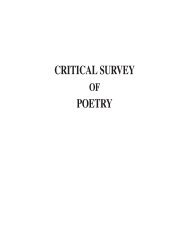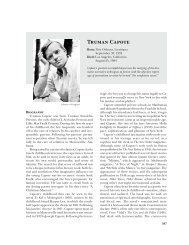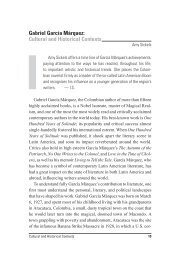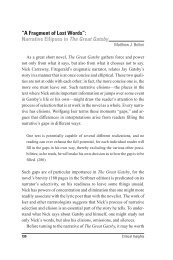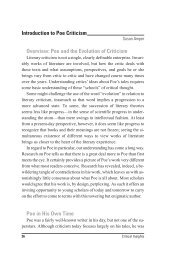The Historical and Social Context of Gwendolyn ... - Salem Press
The Historical and Social Context of Gwendolyn ... - Salem Press
The Historical and Social Context of Gwendolyn ... - Salem Press
You also want an ePaper? Increase the reach of your titles
YUMPU automatically turns print PDFs into web optimized ePapers that Google loves.
naled a major shift in Brooks’s use <strong>of</strong> traditional poetic form. <strong>The</strong> long<br />
poem “In the Mecca” comprises 807 lines in 56 stanzas <strong>of</strong> variable line<br />
length; it is followed by the sequence “After Mecca,” which includes<br />
poems honoring Medgar Evers, <strong>and</strong> Malcolm X, several dedications<br />
for l<strong>and</strong>marks in Chicago, a short sequence titled “<strong>The</strong> Blackstone<br />
Rangers,” <strong>and</strong> other poems. “<strong>The</strong> Blackstone Rangers” is named after<br />
a gang to which Brooks was introduced <strong>and</strong> for the members <strong>of</strong> which<br />
she held poetry workshops. She praises this group, the youths <strong>and</strong> their<br />
girlfriends, feared by whites <strong>and</strong> many blacks; in the second poem in<br />
the sequence, “<strong>The</strong> Leaders,” Brooks proclaims, “<strong>The</strong>ir country is a<br />
Nation on no map” (10). In the Mecca, her final book published by a<br />
white press, was written for an African American audience.<br />
Mrs. Sallie Smith, the mother <strong>of</strong> nine children, is the protagonist <strong>of</strong><br />
“In the Mecca.” She returns home one day from her job as a domestic<br />
<strong>and</strong> discovers one <strong>of</strong> her children is missing. She searches throughout<br />
the apartment building <strong>and</strong> eventually finds her murdered daughter. As<br />
one critic notes, the search for the lost child “reveals the detritus <strong>of</strong> a<br />
failed socioeconomic system, a failed art, a failed religion, <strong>and</strong> their<br />
spawn <strong>of</strong> isolation <strong>and</strong> rage. A general want <strong>of</strong> caritas, Brooks’s major<br />
theme here, defensively mirrors deficiencies <strong>of</strong> the white environment<br />
<strong>and</strong> reflects the Black Mecca as a microcosm” (Melhem, Heroism 17).<br />
<strong>The</strong> name rings with irony. Built in the last decade <strong>of</strong> the nineteenth<br />
century, the Mecca was a tenement in the South Side that was razed in<br />
the course <strong>of</strong> urban renewal projects during the early 1950s (Melhem,<br />
<strong>Gwendolyn</strong> Brooks 158).<br />
<strong>The</strong> disillusionment <strong>and</strong> anger conveyed in “In the Mecca” reflects<br />
the zeitgeist <strong>of</strong> the era. Several major events in the United States in the<br />
early <strong>and</strong> mid-1960s drew much public attention <strong>and</strong>, in some cases,<br />
large public outcry: the Vietnam War, the murder <strong>of</strong> civil rights workers<br />
in Mississippi in 1964, the iconic “I Have a Dream” speech <strong>of</strong> Dr.<br />
Martin Luther King, Jr., <strong>and</strong> the assassinations <strong>of</strong> President John F.<br />
Kennedy <strong>and</strong> Medgar Evers, a major figure in the NAACP, in 1963<br />
(Melhem, <strong>Gwendolyn</strong> Brooks 156). In addition, in 1966 Stokely Car-<br />
32 Critical Insights



